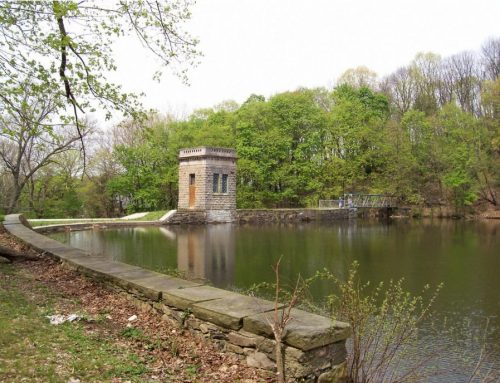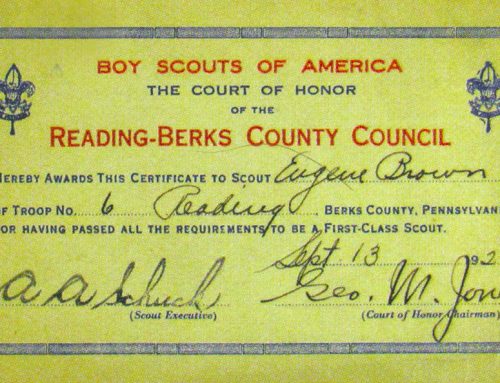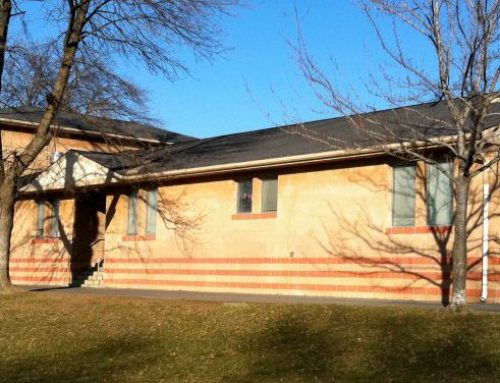Camping has always been essential to Scouting, and was embraced by even the earliest Boy Scouts of Berks and Schuylkill counties, who flocked to summer Scout camps even before Councils had formed to support their fledgling troops.
Throughout the years many camps have come and gone. Some were large facilities that operated for years, while others existed for only a couple of summers. Some lucky troops had their own camps, often donated to them by friends of Scouting. Other camps may have been unrecorded and are largely forgotten. We do know, however, that as long as there have been Boy Scouts in Berks and Schuylkill counties, there have been Boy Scout camps.
A Boy Scout camp was established at the Earlville Dam in southeastern Berks County in July 1911, and a second camp set up in 1917 on the Baby Hill Farm in Antietam. Records provide evidence of various other sites established along area creeks that attracted dozens – even hundreds of Scouts who were anxious to get outdoors and advance their Scouting skills. Camps that have come and gone over the years include Pine Forge, Camp High, Forest Echo, Camp Parish, and Camp Wood Haven. They were spread throughout the area, placed along the Willow Creek, the Tulpehocken, Maiden Creek, Saucony Creek and other locations.
Below: Image Galley – Camping at Pine Forge, 1937 – Touch or Click Images
Noted, among many other reasons, for its unusual name, the former Shikellamy Boy Scout Reservation was named as a testament to the cooperation and friendship among Native Americans and white settlers that occurred during the 1730s, prior to the French and Indian War.
Oral tradition has it that Conrad Weiser, a European who settled in Pennsylvania and became a friend to Native Americans and an emissary in councils between the colonists and Indian tribes, met Shikellamy, Chief of the Oneida Tribe and the Iroquis Confederacy, while they were hunting. The men became friends, and Native American and whites lived together peacefully in the area that would eventually become property of the Daniel Boone Council.
Scout Executive V.L. Huntsberger possessed a keen interest in the history of the region and, during the development of the camp, proposed that it be named Camp Shikellamy, in honor of the great chief. The Council approved the name on April 9, 1950.
Prior to being purchased and developed as a camp, a 54-acre parcel of land on the south side of Blue Mountain, near Bethel in Berks County, was owned by the Blue Mountain Electric Company, which operated a generating station to supply electricity to nearby communities. The land was later purchased by the Metropolitan Edison Company. When it was offered for sale in 1948, the Daniel Boone Camping Committee, which had been looking for land on which to establish a camp, was definitely interested. After much debate and many visits to the site, Council members approached Met Ed officials about buying it. O.G. Titus, Met Ed president at the time, agreed to sell the land to the Boy Scouts for $1, and the Council began planning for a camp.
It very soon became obvious to the camping committee that 54 acres was not going to be enough land. Ralph Body, a prominent Reading attorney and Council member began investigating the possibility of obtaining adjoining properties, and eventually obtained 107 additional acres on five adjoining estates. In 1967 the council purchased the 135-acre Rank farm, giving the camp 296 acres.
Below: Daniel Boone Council Camp

Immediately after Daniel Boone Council obtained the land in 1949, the National Engineering Department of the BSA sent a team of professional camp engineers to Reading, who spent several months drawing up plans for layout of the camp. Council President Fred A. Howard appointed the Reverend Monsignor Henry Huesman as Chairman of the Camp Development Committee, and the Council proceeded with a three-year plan to provide water, roads, maintenance, storage, latrines, showers and a home for the camp ranger.
The Council initiated a $150,000 capital campaign in 1950, and exceeded its goal by raising $153,000. The money was used to build a warehouse, latrines for ten camps, showers, a health lodge, an administrative building, a tented dining hall, and a makeshift kitchen, all completed by 1951.
The camp was located on the side of a mountain with no stream, raising the question of a swimming area for campers. C. W. Good, a member of the Council Camping Committee and a contractor who built Route 22 through Bethel, was asked to look over the site and recommend a plan to build a three-and-a-half-acre lake. Good did just that, and volunteered to build the lake as soon as he could free his equipment from highway construction. About a year later his company completed the job as a contribution to the youth of Berks County, and, on July 27, 1951, the lake was dedicated as “Lake Good.”
Shikellamy did not officially open until the 1951 season, but Scoutmaster William Wolfinger was named as the first camp director in 1950 and some Scouts attended. The first camp to open was called Camp Unami, which served 150 to 200 boys per week during the years between 1950 and 1958.
A capital campaign in 1959 raised $360,000, resulting in significant expansion. Generous donations resulted in the Hafer Lodge, funded by and named for Paul Hafer and his father, Frank Hafer; Howard Chapel, funded by the Howard family in memory of Frank H. Howard; a beautiful swimming pool and tents, funded by Dr. H. K. Willits and his wife; Geiss Lodge, funded by Newton W. Geiss and his wife; Senner Hall, the main dining hall, funded by William Senner; the Nature Lodge, funded by John From; and the Boonesboro Camp Site and Boonesboro Lodge, funded by Pack, Troop and Post 24.
Below: Image Galley – Shikellamy Boy Scout Reservation – Touch or Click Images
The name of Camp Unami was changed to Camp Minsi, which, when completed, featured a rifle range, summer and winter lodges, a 300-person capacity dining hall and a complete kitchen with a walk-in refrigerator. Each campsite in Camp Minsi was given an Indian name.
As part of its regular training, the Navy Seabees, headquartered in Allentown, spent two weekends at Shikellamy during the spring of 1960, building latrines, clearing roads, laying a water distribution system, overhauling the kitchen and revamping the telephone and loud speaker communications systems.
A second camp – Camp Pioneer – was built, and each of its campsites named after a frontiersman or a fort. This camp was a duplicate of Camp Minsi, except Scouts were served by heater stacks – food delivered to the camp site by a truck from the main kitchen – instead of a dining hall. To everyone’s surprise – perhaps most of all the campers – the idea of heater stack camping was accepted. The stacks provided a different experience than the dining hall, but an acceptable one.
Ray “Pappy” Willhoyte was hired as Camp Ranger in 1961, and would stay on until retiring in 1990, eventually assuming the duties of ranger for Hawk Mountain Scout Reservation following the consolidation of Daniel Boone and Appalachian Trail councils.
By 1968, Camps Minsi and Pioneer, were serving 500 boys per week, and a number of traditions had developed. The Bear Claw award was one of them, presented to patrols and troops which prepared at least three meals and participated in at least one overnight campout while at camp. Another tradition was the competitive water carnival held at Camp Minsi on Friday afternoons. And, Camp Pioneer developed an adventure trail with Scoutcraft skill competitions.
Another tradition was the Shikellamy Award, inaugurated in 1951 to recognize two individuals each year who had offered outstanding contributions, either in time, service, or money, to the Shikellamy Boy Scout Reservation. Chief Scout Executive Dr. Arthur Schuck presented the first awards in 1951.
The name Shikellamy Scout Reservation was dropped in October of 1973, following the consolidation of Daniel Boone and Appalachian Trail councils two years earlier. Shikellamy and Blue Mountain Scout Reservations were merged into one – Hawk Mountain Scout Reservation, which operated three camps: Minsi and Pioneer, both at the former Shikellamy Scout Reservation, and Nisatin at the former Blue Mountain Scout Reservation.
Many Scouts and Scouters still recall fondly the times spent at Camp Shikellamy, a place where friendships were forged, Scout skills enhanced and memories made.
























Leave A Comment